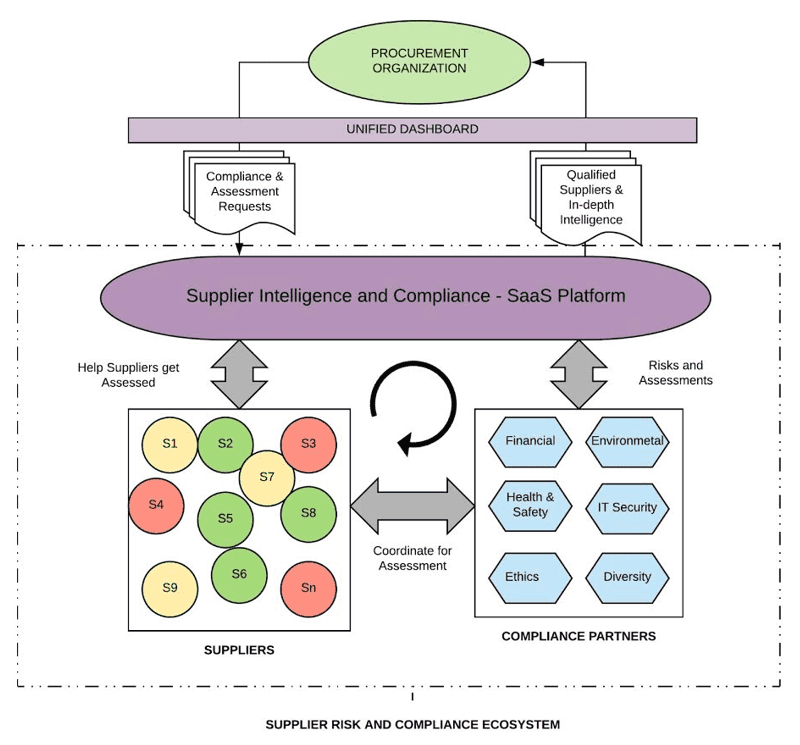
Supplier Compliance is Ripe for the Fabled Tech Disruption: Customer Interface

With inputs from Ipsita Suman, Principal Analyst

Global Procurement Organizations have an accreditation process to ensure that their suppliers are vetted on several key parameters such as sustainability, financial risk, and information technology (IT) security. The aims of such an accreditation process are as follows:
- Align suppliers with the organization’s supplier code of conduct
- Reduce supply chain risk
Organizations seek to ensure compliance around major areas where they want suppliers to follow some operating ground rules. However, ensuring compliance is no easy task and, as such, is a major operational inconvenience to procurement teams.
Nearly 70 percent of procurement managers said they play an active role in managing supplier compliance/governance, according to a poll conducted among users of Beroe LiVE, a community of thousands of procurement decision makers.
The major pillars of the supplier compliance process include, but are not limited to, the following:
- Financial risk
- Health and Safety
- Diversity
- Ethics
- IT Security
- Environment
Compliance Methodology
In-house Questionnaire
Internal forms built in MS Excel/Access are circulated to suppliers to obtain details about their compliance status.
Certification on the Platform
A better and seamless way of getting the requisite certification is by developing a layer on the enterprise resource planning system and onboarding suppliers to enter their certification/compliance status on the platform.
Automating Compliance
Third-party specialist service providers help organizations prepare supplier questionnaires for certification. They also have a self-sustaining platform and specialists to help Procurement Organizations develop and customize the platform.
According to the procurement sustainability and supplier compliance advisor Christel Costagli, irrespective of whether organizations have invested in third-party platforms or systems to manage the qualification and compliance assessment process, or have built a simpler in-house program, the course of action to assess supplier compliance likely includes the following steps:
- Assign a risk level to a supplier based on risk indicators, such as type of product or service to be provided, spend, geography and supplier criticality.
- Conduct due diligence to evaluate supplier compliance with standards set by the company’s sourcing policy. The depth of due diligence reflects the level of risk. The due diligence measures may range from analysis of suppliers’ policies or operating models through questionnaires to on-site audits.
- Identify gaps against the minimum standard or required practice and determine where performance needs to be improved. This leads to a compliance score and either a qualification validity period or a review within a given timeline. Some companies may qualify suppliers that are not yet fully compliant but have committed to make improvements.
- Monitor implementation of the improvement plan.
- Reassess periodically depending on the compliance score and risk level assigned to the supplier form.
Common Pain Points in Certification Management
Supplier Cooperation
Most suppliers do not have a dedicated team set-up to manage compliance or certification requests from buyer organizations. Small and medium-sized enterprises also view this as a resource-consuming activity. Thus, buyer organizations must follow up a number of times to obtain information from the suppliers, which is time consuming.
Targets, regulations, laws and culture vary across regions. Coordinating the compliance/certification activity on a global level requires time, resources and planning.
“One of the pain points in compliance data collection is the responsiveness of the supplier. Establishing contact with the right person/department in supplier organization requires multiple follow-ups. Unless the compliance is specified as mandatory by the buyer, suppliers are largely slow in their response and almost reluctant to share the certification details. On the other hand, if the compliance is mandated in the supplier contract, then the response rate is relatively better,” according to a project manager who is not authorized to speak on behalf of the company.
Legal Risk
The legal risks are high if a client is unable to get a supplier certified on time. Certifications help clients protect themselves against legal risk. Thus, unless their suppliers are certified, clients may not be able to estimate the risks involved.
The Way Forward: Customer Interface
Supplier compliance is now split across various work streams, methodologies, databases and reporting structures. While technology is increasingly easing the burden, there is still much room for improvement. According to a recent Dun & Bradstreet report, 216 respondents, who are in charge of compliance, noted that technology is still one of the barriers preventing them from doing their job effectively.
Of those 216 respondents, 71 percent have experienced fraud in the last two years, which has also damaged the brand. Feedback from these respondents highlights the need for an effective technology infrastructure to support the risk-based approach and aid decision making.
The way forward will involve offering a centralized customer interface in a software-as-a-service or SaaS model that will contain all types of compliance data and supplier certification.
“A well-defined SaaS model will require procurement users to interact with just one system instead of having to interact with multiple suppliers and compliance service providers. This will help cut down time and effort in managing the overall compliance program of an organization,” Supriyo Mukhopadhyay, Head of Technology at Beroe Inc said.

While many service providers offer cloud-based technology to ensure compliance, none so far offers an overarching solution for all types of certification and compliance across all parameters -- ranging from vetting a supplier’s financial risk status to identifying and working with diverse suppliers. In other words, no aggregators exist to aggregate all types of supplier compliance information from service providers and present them in a seamless interface to procurement teams. In other words, building an agile customer interface will define the future work flow process.
The battle for a building a robust customer interface has disrupted traditional industries across the globe. Technology strategist Tom Goodwin once wrote the following:
“Uber, the world’s largest taxi company, owns no vehicles. Facebook, the world’s most popular media owner, creates no content. Alibaba, the most valuable retailer, has no inventory. And Airbnb, the world’s largest accommodation provider, owns no real estate.”
To borrow Goodwin’s analogy, the service provider who eventually manages to offer a seamless customer interface that aggregates all types of compliance data will sit on top of vast compliance systems and interface with a large number of people. The aggregation should ideally result in the ease-of-use, which alone will triumph over the services offered by other full-stack service providers.
Besides providing easy access for compliance checks and reporting, a common supplier repository ensures that all data are present at a single location, which would enable error-free reporting.
The aggregation model will provide buyers a ready list of prequalified suppliers. Suppliers can also benefit from the emergence of new business opportunities as their compliance data can be accessed centrally by Purchasing Organizations across the globe.
“New legislations are being regularly introduced to place demands upon organizations to be more transparent about issues in their supply chain and about what they are doing to address them. To abide to these requirements, companies must equip themselves with the ability to consolidate supplier information and standings, and report progress,” Christel Costagli said.
As a first step, companies individually will have to consider consolidating supplier information internally until a new player emerges who can successfully introduce the customer interface model to the world of supplier compliance. The day is not far off.
Related Insights:
View All
Get more stories like this
Subscirbe for more news,updates and insights from Beroe






